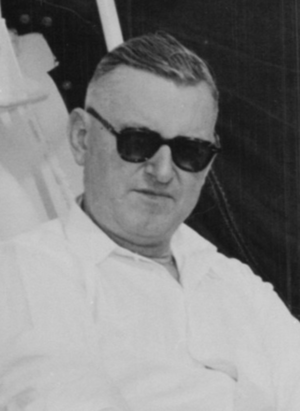John Steelman
( bureaucrat) | ||||||||||||
|---|---|---|---|---|---|---|---|---|---|---|---|---|
 | ||||||||||||
| Born | 1900-06-23 Thornton, Arkansas, U.S | |||||||||||
| Died | 1999-07-14 (Age 99) Naples, Florida | |||||||||||
| Alma mater | • Vanderbilt University • University of North Carolina | |||||||||||
| Party | Republican | |||||||||||
White House Chief of Staff for Harry S. Truman
| ||||||||||||
John Roy Steelman (June 23, 1900 – July 14, 1999) was the first person to serve as "The Assistant to the President of the United States", in the administration of President Harry S. Truman from 1946 to 1953. The office later became the White House Chief of Staff.
He holds the record for the longest term as Chief of Staff at six years.
Background
John Roy Steelman was born on a farm in Thornton, Arkansas, the son of Martha Ann (née Richardson) and Pleasant C. Steelman. After graduating from high school, he was in World War I. To save money for college tuition, he held jobs that included bookkeeping, logging and agriculture. He rode the railways to Wichita, Kansas, to work in the wheat fields and proudly recalled his time as a blanket stiff, the label used among hobos for a migrant laborer who carried his blanket with him.[1]
Steelman was a descendant of Olof Persson Stille, an immigrant to New Sweden and chief justice of one of its courts, some of whose descendants Anglicized their surname from Stille to Steelman.[2]
Steelman attended Henderson Brown College in Arkadelphia, Arkansas and graduated in 1922. He later went to Vanderbilt University, where he earned his MA in 1924. He received his Ph.D. in 1928 from University of North Carolina in economics and sociology. He was Professor of Sociology and Economics in Alabama College in Montevallo, Alabama from 1928–1934.[3]
Career
After completing his Ph.D., Steelman embarked on a career in academia. He was an instructor at Harvard University before becoming a professor of sociology at Alabama College. Frances Perkins, then Secretary of Labor, delivered the commencement address there in 1934. She met Steelman and admired his recent settlement of a labor dispute in Mobile, Alabama. Ken Hechler describes how impressed Perkins was with "the huge, open-faced, smiling man who taught economics but talked like a down-to-earth fellow...he seemed to know what he was talking about on all the labor issues that interested Secretary Perkins."[4] She convinced him to join the federal government as a member of the United States Conciliation Service, which assisted in settling labor disputes, and later became the Federal Mediation and Conciliation Service (United States). After three years he became Commissioner of Conciliation.
After President Franklin D. Roosevelt was elected to a fourth term, Steelman worked for a short time in New York City as a public relations consultant. But when Roosevelt died in 1945 and Vice President Harry Truman became President, Steelman returned to the federal government as an adviser to the Secretary of Labor. Later he became a special assistant to the President, serving as Director of the Office of War Mobilization and Reconversion. In 1946, he became "The Assistant to the President." In 1948, he turned down the post of Secretary of Labor, preferring to stay at the White House, where he was particularly focused on establishing policies on science and higher education.
Before joining the White House, Steelman served as:
- Commissioner of Conciliation, U.S. Conciliation Service, Department of Labor 1934–36
- Special Assistant to the Secretary of Labor 1936–1937
- Director, U.S. Conciliation Service, Department of Labor 1937–1944
- Special Assistant to the President, 1945–1946
- Director, Office of War Mobilization and Reconversion, 1946
- Chairman, President's Scientific Research Board, 1946–1947
- Assistant to the President, 1946–1953
- Acting Chairman, National Security Resources Board, 1948–1950
- Acting Director, Office of Defense Mobilization, 1952
After leaving the White House, Steelman became an Industrial Relations Consultant in Washington, D.C. from 1953–1968. From 1955 to 1969 he was in a variety of corporate roles:
- President of the Montgomery Publishing Company
- Chairman of the Board of the Record Publishing Company
- Publisher of newspapers in Bethesda, Silver Spring, and Rockville, Maryland
References
- ↑ John Steelman, 99; From Riding the Rails to Top Truman Aide The New York Times, 22 July 1999
- ↑ https://web.archive.org/web/20091115095000/http://www.colonialswedes.org/Forefathers/Stille.html
- ↑ John Steelman, 99; From Riding the Rails to Top Truman Aide The New York Times, 22 July 1999
- ↑ Ken Hechler, 'Working with Truman: A Personal Memoir of the White House Years,' University of Missouri Press, p. 45